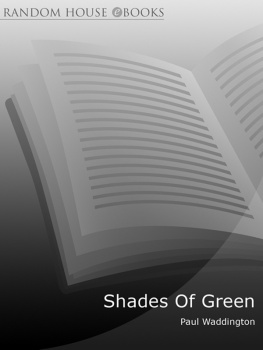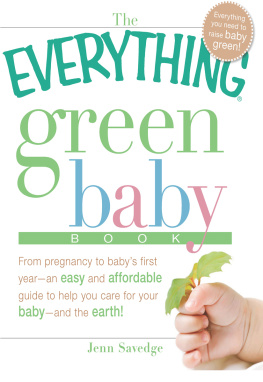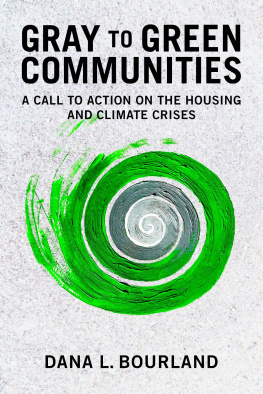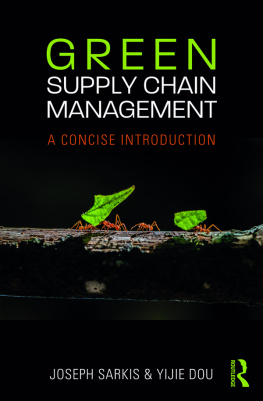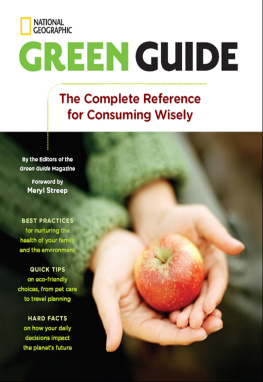SHADES OF GREEN
A (mostly) practical AZ for the reluctant
environmentalist
Paul Waddington

Contents
This eBook is copyright material and must not be copied, reproduced, transferred, distributed, leased, licensed or publicly performed or used in any way except as specifically permitted in writing by the publishers, as allowed under the terms and conditions under which it was purchased or as strictly permitted by applicable copyright law. Any unauthorised distribution or use of this text may be a direct infringement of the authors and publishers rights and those responsible may be liable in law accordingly.
Version 1.0
Epub ISBN 9781407004464
www.randomhouse.co.uk
TRANSWORLD PUBLISHERS
6163 Uxbridge Road, London W5 5SA
A Random House Group Company
www.rbooks.co.uk
First published in Great Britain in 2008 by Eden Project Books an imprint of Transworld Publishers
Copyright Paul Waddington 2008
Paul Waddington has asserted his right under the Copyright, Designs and Patents Act 1988 to be identified as the author of this work.
A CIP catalogue record for this book is available from the British Library.
ISBN 9781905811007
This book is sold subject to the condition that it shall not, by way of trade or otherwise, be lent, resold, hired out, or otherwise circulated without the publishers priorconsent in any form of binding or cover other than that in which it is published and without a similar condition, including this condition, being imposed on the subsequent purchaser.
Addresses for Random House Group Ltd companies outside the UK can be found at: www.randomhouse.co.uk The Random House Group Ltd Reg. No. 954009
The Random House Group Ltd supports The Forest Stewardship Council (FSC),the leading international forest-certification organization. All our titles that are printed on Greenpeace-approved FSC-certified paper carry the FSC logo. Our paper procurement policy can be found at www.rbooks.co.uk/environment

Typeset in 12.25/15 pt Weiss BT by Falcon Oast Graphic Art Ltd.
Printed and bound in Great Britain by CPI Mackays, Chatham, ME5 8TD
2 4 6 8 10 9 7 5 3 1
Paul Waddington is the author of Seasonal Food and 21st Century Smallholder. He tries to live as sustainably as possible with his wife and two children.
www.rbooks.co.uk/eden
Also by Paul Waddington
Seasonal Food
21st Century Smallholder
Introduction
Just exactly how green are the various choices we make? Is it better to use a dishwasher or wash up by hand? Is local food always greener than stuff that has travelled thousands of food miles? Where are hybrid cars on a scale where 1 is tremendously green and 10 is Jeremy Clarkson? Is it better to sign up for green-tariff electricity or to stick a windmill on your roof? Its often difficult to navigate the green minefield. There are a couple of good reasons for this. The main one is that we need to take a common view of what green actually means. Does it always mean low mpg, low food miles, low technology and no fun? Or does it sometimes mean choices that are a bit less obvious? The second complication is that there are plenty of people out there telling us that their solution is the greenest, when maybe it isnt.
Greenness used to be about railing against industrial and agricultural pollution, supporting biodiversity, saving the whale, finding alternatives to dwindling oil reserves. Its still about these things and thanks to the efforts of green campaigners we have cleaner rivers, tighter environmental legislation and a much better awareness of environmental issues. However, if we are to accept the global scientific consensus (and the few who reject it mostly have some sort of ideological axe to grind) then the big deal today is greenhouse gases, in particular CO2, of which human activity produces more than the biosphere can comfortably deal with. Divide a sustainable level of anthropogenic (human-generated) CO2 emissions by the worlds population and you come to an amount which each of us should emit: this is currently 2.4 tonnes per person per annum, a quarter of the UKs current per-person CO2 emissions of around 10 tonnes.
So the definition of green in this book is firstly about the degrees to which the choices we make result in CO2 emissions. Put this into context and it can look dispiriting. Britain is responsible for 2 per cent of global anthropogenic CO2 emissions. Of these, less than 50 per cent are the domestic emissions we can easily control with our choices; and of these, space- and water-heating, travel and our food choices are the most influential. Feeling morose about it, we could mumble that even if, say, we all changed our light bulbs tomorrow, on a global scale it would affect a fraction of 3 per cent of a fraction of 2 per cent of energy use. It is undeniable that in the global scheme of things, successfully lobbying China to mandate total carbon-capture and storage technology in each new coal-fired power station it allegedly opens every week will have a vastly bigger impact on greenhouse-gas emissions than anything we can do in our houses. But lots of small changes scaled up to national level have had a measurable impact before and are having one now: unleaded petrol, CFC-free aerosols or the move to mandatory energy-efficient boilers.
Beyond CO2 emissions, green in this book also denotes activities that use resources (e.g. water, agricultural land, wild fish) at a sustainable level, and that have no net deleterious effect on the biosphere. Here, again, small changes can make a big difference nationally, whether its toilets that use half as much water or detergents that chuck fewer phosphates into our rivers.
But whatever choice it is you are contemplating and despite what the vendors of wind turbines, hybrid cars or eco-holidays might suggest to you being green is never black and white. There are always shades in between. And whilst many of us may have decided not to do the least green thing, the very greenest thing may be too extreme.
So what are the shades of green in the choices we make? Using an informal ranking that runs from deep green to not even a little bit green, this book identifies and explains them. Its not a rigid, scientific scale with green points; its designed to give you an idea of how green various different choices are. They are not always what you would expect; nor are they always strictly practical. Nor does the book cover all the choices we make; but for the things that have been omitted, you will most likely be able to work out the shades of green for yourself. The things that have been chosen are those that have the most important environmental effect, and those that have interesting or unexpected shades.
The good news is, that whatever the choice you are making, in most cases there is a shade of green for everyone.
Aeroplanes
T he best thing we can do with environmentalists is shoot them. Ryanair boss Michael OLearys decidedly un-relaxed attitude to green issues, hinted at in this November 2005 quote, shows how touchy the aviation industry can be about its rapidly growing environmental impact. It may account for only around 25.5 per cent of the UKs CO2 emissions (depending on whether you believe the industry or the government), but the issue with aviation overall is its projected rate of growth set against the CO2 reduction targets to which the UK has committed itself. Emissions from the UK air-transport industry have more than doubled since 1990. Put the governments forecast aviation growth by 2050 next to its commitment to reduce CO2 emission by 60 per cent by the same year, and aviation will account for half of all CO2 the country is allowed to emit. Go for the more serious emissions reductions that many are recommending, and no other activities would be allowed to produce any CO2 if aviation continued to grow at current rates. The twin problems with aviation are the distances involved, which result in very large volumes of greenhouse gas per passenger; and the fact that those emissions, deposited as they are at high altitudes, cause additional radiative forcing effects which are estimated to multiply the effect of the emissions 2.7 times. So even without the forcing effect, a family of fours round trip to Disneyland in Florida puts nearly 8 tonnes of CO2 into the atmosphere: it would take 48,270 kilometres of driving in the family Mondeo to create the same emissions. With no significant efficiency gains in aircraft coming any time soon, it aint easy to fly and be green.

